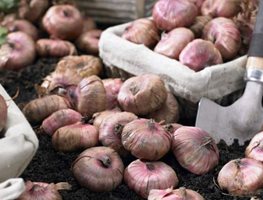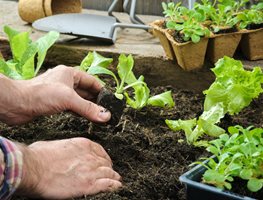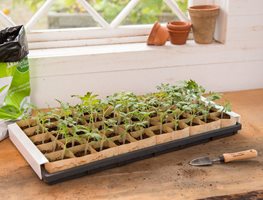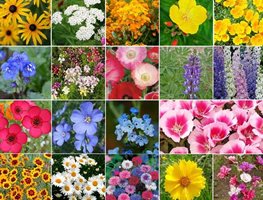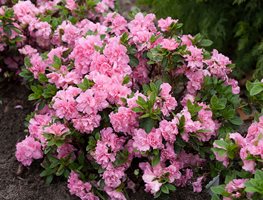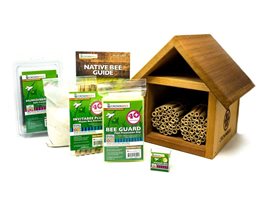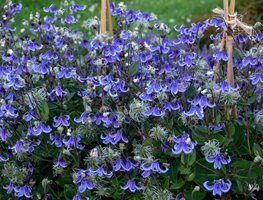10 Gardening Activities for February in Southern California
Here are a few garden reminders, inspiring ideas, and maintenance suggestions for this month.
1. Get Spring-Planted Bulbs, Corms, Tubers & Rhizomes in the Ground
You should have all your spring-planted bulbs in hand (ideally, you ordered back in January). If not, you can order bulbs such as calla lilies, dahlias, gladiolus, lilies, ranunculus, and others from online retailers such as Longfield Gardens or Brent and Becky's Bulbs, or caladiums from Proven Winners. When planting, be sure to amend soil with an organic bulb food.
2. Plant Cool-Season Crops
Transplant or direct sow your cool-season crops. You can transplant beets, broccoli, cabbage, cauliflowers, Swiss chard, celery, kale, leeks, lettuce, and onions. Arugula, carrots, parsnips, peas, radishes, spinach, and turnips are better when direct sown in garden beds. When transplanting or sowing seeds be sure to amend soil with organic compost. Keep a consistent watering schedule. For direct sown seeds, keep your soil evenly moist but not wet over the next few weeks as seedlings emerge.
3. Start Summer Crops Indoors
Technically, most of Southern California can start these crops earlier (in late-December or January) but it feels odd to be planting tomatoes at Christmas. Instead, wait until early February to start most summer crops so, when it’s time to transplant them the weather is truly starting to warm up. Most of these summer crops such as tomatoes, melons, peppers, or squash prefer warm weather to really start growing, so planting early won’t help much anyway. If you plant in early February, then your starts should be ready to transplant sometime in March. Be sure to get a good seed-starting kit and use adjustable grow lights once seedlings have sprouted. Adjustable grow lights ensure that starts don’t get leggy or grow sideways as they search for sunlight on a window ledge.
4. Continue Planting Cool-Season Annuals
Cool-season annuals can be planted in the garden, in containers, or in hanging baskets. Annuals such as pansies, violas, Iceland poppies, English daisies, Osteospermum daisies, primroses, and nemesia will bring vibrant early season color to areas around patios, porches, and walkways. Plant in locations along walkways that are used frequently, or outside windows to increase the impact of your planting. Look for annuals at your local nursery or order online from Proven Winners. Or to really make it easy, order pre-planted Flower Pillows.
5. Bring in Flowering Branches
Cut flowering branches to bring indoors for floral arrangements. If branches are already in bloom, then simply place them in a large vase filled with water (larger vases will help prevent branches from tipping over). Branches that are still in bud can be forced to bloom indoors and often last longer than cutting branches already in flower. Trees and shrubs that are often forced include tulip and saucer magnolia, flowering cherry, forsythia, witch hazel, ornamental pear, redbuds, quince, and willows. To force blooms, soak your cut branches in room-temperature water for around 8 hours. Then recut stems and place in a vase filled with cool water. Place the vase in a cool room out of direct sunlight until buds open. Then move the vase and branches to a warmer room for displaying.
Don't miss what to do in the garden each month, make sure you're getting our weekly newsletter.
6. Plant California Wildflowers
If you didn’t plant wildflowers in the fall, then this is a good time if you’re planting in an area that receives supplemental irrigation (or if you’re going to water by hand). In open fields that will rely solely on rainfall, it’s best to only plant in fall. When planting, be sure to clear the soil of any weeds, grass, or other unwanted debris. Look for wildflower seeds at online retailers such as Eden Brothers—try the Coastal California Wildflower Seed Mix.
7. Feed Azaleas & Plant More
Azaleas are likely starting to bloom this month. Be sure to keep them well fed during the bloom season with a high-phosphorus fertilizer. For the rest of the year, fertilize with an acidic fertilizer. It can also help to add peat moss to soil around azaleas and mulch with shredded redwood or pine needles which tend to be acidic as they break down slowly into the soil. It’s also a good time to plant azaleas when you start seeing the flowers blooming at local garden centers (then you can see the bloom colors in person). You can also order online from retailers such as Proven Winners, Singing Tree Nursery, or Plants by Mail.
8. Take a Short Course on Flower Arranging
As bulbs and flowers begin to bloom around you, it’s fun to study floral design so you can figure out how to use all the bounty from your garden. There are several ways gain some floral design knowledge. First, get a good book on floral design. These are all great options:
There are also many good articles on floral design like “A Crash Course for Easy and Elegant Florals”. You can also take in-person classes or online courses
9. Raise Mason Bees
Start raising mason bees in your garden. They're not aggressive, and they’re active pollinators for crops and orchards. Consider buying a kit that includes a mason bee house, attractant, and bee cocoons. You can read more about raising mason bees on the Ecological Landscape Alliance website.
10. Prune Clematis & Some Other Vines
You’ll want to prune any vines before spring growth begins to emerge; notably, clematis—you should prune it this month and fertilize it once new growth appears. You can pre-order clematis from retailers such as Proven Winners and they will ship plants at the best planting time for your zone. For other types of vines, read up on when to prune different varieties to make sure you don’t cut off branches that will form flowers. The Brooklyn Botanic Garden has a great guide on pruning vines.
If you enjoyed this information, sign up for our weekly newsletter. Each week, you'll get Garden Design's best delivered right to your inbox including design tips, plant picks, great gardens, outdoor living products, and events to enjoy — along with monthly gardening checklists just for your area.
Do you know someone who would enjoy this Southern California Region gardening information? Why not share it with them?
When you purchase products through links on our site, we may receive an affiliate commission. Thank you for your support.
